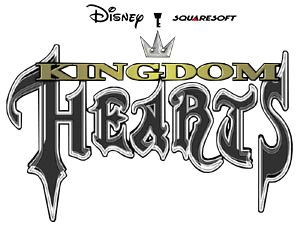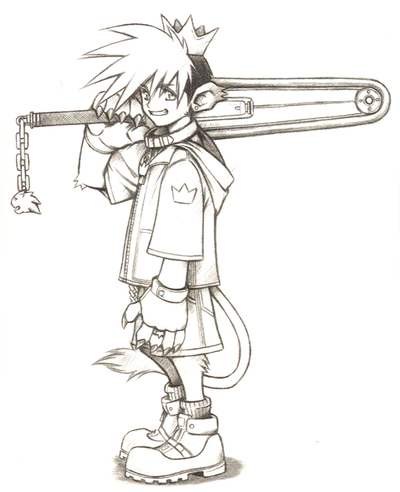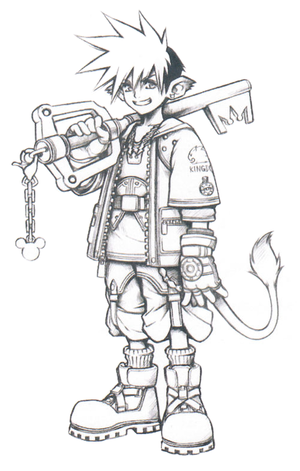Prerelease:Kingdom Hearts
This page details prerelease information and/or media for Kingdom Hearts.
| This article is a work in progress. ...Well, all the articles here are, in a way. But this one moreso, and the article may contain incomplete information and editor's notes. |
| This page or section needs more images. There's a whole lotta words here, but not enough pictures. Please fix this. |
To do:
|
The initial idea of Kingdom Hearts' started out as a fateful encounter between Squaresoft (later Square Enix) and Disney Japan, where Tetsuya Nomura went ahead with the idea because he wanted to create an open-world action RPG game. Many potential rule-breaking risks were taken throughout development, under the fear that the Walt Disney Company in America would turn the idea down, but development continued on smoothly, under closer supervision from the company. Despite that, several ideas had to be cut or changed-around to fit with the storyline of the game better or due to time constraints at that time.
It ended up being a massive success, capturing the attention of Disney, Final Fantasy and general role-playing game fans around the world while also managing to balance and retain the charm that was borrowed from the source material. What would be one of the most unique games would end up segueing into a deeper and expansive saga.
Developmental Timeline
1999
- Mid-Dec. Nomura finishes writing the story of Kingdom Hearts.
2000
- Jan. - Bob Iger and Robert Eisner visit Disney Japan to get their approval on Kingdom Hearts project, where despite all the rule-breaking circumstances ended up getting approval from them.
- Feb. 11 - A "secret game" is confirmed to be announced at the Sony Festival 2000.
- Feb. 18 - A Disney and Square Enix collaboration game is announced at the Sony Festival 2000, showing off 3D animation reels of characters behind closed doors.[1]
2001
- May 23 - Kingdom Hearts is revealed at E3 2001.
- Oct. 12 - More footage of the game is shown at the Tokyo Game Show 2001.
- Dec. - Japanese Voice recording for Kingdom Hearts begins.
2002
- Jan. 31 - More images are shown.
- Mar. 28 - Kingdom Hearts is released in Japan.
- Jul. 29 - English localization for the game is announced.
- Summer - Kingdom Hearts Final Mix is announced.
- Sep. 17 - Kingdom Hearts is released in North America.
- Nov. 15/22 - Kingdom Hearts is released in Europe and Australia, respectively.
- Dec. 26 - Kingdom Hearts Final Mix is released in Japan.
1999
Early Development
Initial Ideas
The initial concept of "Disney RPG" came from an elevator ride in an office building where Squaresoft and Disney Japan had been situated at that time. Hironobu Sakaguchi of Disney Japan first thought up the idea when he met Squaresoft employee Shinji Hashimoto, and both discussed how they would both like to work together sometime. They both talked with Disney about the idea, where Tetsuya Nomura was present and decided to join in.
Tetsuya Nomura had the idea of wanting to make an open-world action RPG game from playing Super Mario 64, where he was impressed with the open environments. To make the idea sell, he wanted to use characters that had the same recognition as Mario, such as Disney characters for example. It was when the conversation happened and joined in on the project.
The name of the project originally had the title Kingdom, because Nomura wanted something that "isn't supposed to be taken lightly" and had thought of the name from the real-life Disney's Magic Kingdom and Animal Kingdom locations. Trademark issues led to the name being extended, whereas Nomura thought of rather humorous name ideas such as Kingdom Champions but he wanted the story to have "heart" as the theme. At first, Nomura thought of Kingdom Heart and Kingdom of Hearts, but it didn't work well until he eventually went with Kingdom Hearts in the end. [2]
Deciding on Worlds
When Nomura traveled to the Walt Disney Company in Los Angeles to discuss with them about developing Kingdom Hearts, Nomura didn't want the game to be limited to one world, so the idea of travelling to multiple worlds in one came to be. The team also gets to view upcoming Disney films before public release, so they can get a head start on designing the world for it.
The team initially opted for 30 or 40 worlds, but was drastically downgraded to eight due to limitations and that kind of amount being suited for bigger-scale projects. They chose some of the worlds based on a list of films in the Disney Animated Canon by popularity at the time, up to Tarzan.
Squaresoft is the one that handles the decision on which movie gets to be featured as a world, rather than Disney themselves. They also choose them based on ideas that they can come up with, presenting it to Nomura and eventually Disney themselves for approval. Nomura is against putting in worlds that have a similar feeling to each other, such as Tarzan and The Jungle Book sharing the same jungle theme for example. Worlds are also chosen based on their relevance to the storyline of the game, in terms of the themes presented while also following the storyline of the movie.
Scrapped Worlds
- A world based on The Jungle Book was planned to be included, but it was cut due to Tarzan being a new and popular film at the time, combined with the redundancy of multiple jungle-themed worlds.
- A Toy Story world was planned, as seen in the design document, but it ended up having to be cut twice due to Pixar and Disney being completely different companies at the time. A world based on this film did finally appear in Kingdom Hearts III however.
- A world based on The Lion King was cut due to time constraints and a theoretical four-legged Sora requiring additional programs to make it work. A Lion King world was able to be completed for Kingdom Hearts II.
- A world based on Atlantis: The Lost Empire was planned to appear to tie in with the release of the film, as well as fitting with the Gummi Ship element, but the story didn't connect well with the other worlds.
Designing Characters
The process for replicating 2D characters into 3D was rather tricky. Squaresoft staff had to watch the same footage of characters over and over again to perfectly replicate their movements and animations into 3D graphics.
Concept Art
Characters
Sora
Sora was the very first original character created. Originally he had "beast-like features" such as a tail and ears and an outfit with straighter lines before it was made rounder. When Nomura showed off the design to Disney in America, they were shocked, especially with the chainsaw-like weapon.
To not avoid anything that would be considered too violent, Nomura redesigned the weapon into a Keyblade, taking cues from Disney designs. Besides killing enemies, he also wanted to give Sora a "key to free and take back hearts." In the earliest screenshots, the design for the Keyblade used an orange-and-black color scheme.
| One of the earliest final designs. | A work-in-progress of the final design. | The final design. |
His outfit underwent a redesign when it was decided that Donald and Goofy were Sora's partners, taking on a rounder, Disney-inspired shape. The tail was dropped so the design wouldn't conflict with Zidane from Final Fantasy IX, and the beastly features went with it.
Riku
Kairi
Donald and Goofy
| Costumes designed by Ken Christiansen of Disney Interactive. | A later Goofy design, now without a sword. | Donald's later design, which heavily resembles his final design. | The final designs. |
The initial Knight and Mage designs for the duo were designed by Ken Christiansen of Disney Interactive. Disney wouldn't allow Donald or Goofy to punch or kick enemies, so the sword was removed from Goofy's design. Disney also requested that Ken Christiansen tweak the designs to be more Nomura-like, fitting Sora's design.
Scrapped Characters
Rikku
At one point during development, Rikku[3] was originally going to fulfill Yuffie's role in the story with Yuffie being in another world entirely, but was ultimately scrapped.[4] We'd see Rikku in a different form in Kingdom Hearts II.
Worlds
Destiny Islands
One of the very first pieces of concept art for Destiny Islands show that it originally had a lot of slides.
Disney Castle
Disney Castle was originally more of a kingdom of some kind.
Earlier Story Elements
Chernabog Final Boss Fight
Concept art found in the Kingdom Hearts design document shows that Chernabog was originally planned to be the final boss rather than Ansem, Seeker of Darkness. The above artwork also shows the fight taking place not at Bald Mountain within End of the World, but rather within Hollow Bastion.
2000
January
Eisner's Approval
Shinji Utsumi had the task of presenting Kingdom Hearts to Disney CEO Michael Eisner and Bob Iger, when the game was under its full development stages. At that time, Squaresoft didn't know that the game was fully-approved as they were only talking with Disney Japan about it and there was no one this big of an authority to make such decisions.
The chances of the project getting approved was very minimal; Disney never approved a license in Japan for a title with a completely new setting, nor combined multiple franchises altogether into a singular title nor had a style guide for creating a 3D Mickey Mouse model. Despite Disney Japan warning that Utsumi would cancel the project if it didn't get approved, He had prior knowledge of discussing matters with other members, including his boss in the United States and head of brand management.
The meeting with Eisner and Iger consisted of over a hundred members of Disney Japan, where they formally answered questions and presented their ideas. The staff members took note of every word he said, which felt more of an old Japanese business meeting in comparison to one in the west.
"Keep at it, and do it right."
- Michael Eisner[5]
Though Eisner didn't show any praise, he showed encouragement instead which made the staff members happily realize that they've been given permission amidst the many liberties they had taken with the Disney branding. https://www.khinsider.com/news/Otocoto-reveals-history-of-how-Kingdom-Hearts-got-approved-by-Eisner-17299
February
Sony Festival 2000
Information about a Squaresoft and Disney game were revealed at the Sony Festival 2000 behind closed doors where it showed animations of Goofy in 3D.
2001
May
E3 2001
Trailer
The game was fully unveiled at E3 2001, which had a release date of Winter 2001. The exact same trailer can be found on a Square Preview Disc.
- The models for Sora, Kairi and Riku look less high-poly in cutscenes along with having early texturing, which could probably mean that cutscene models weren't made for them yet. Curiously, the early Sora model ended up being used in Kingdom Hearts II, albeit being darkened due to the cutscene taking place at night, during a flashback cutscene in the 100 Acre Wood.
- The cutscene at the beginning of the trailer takes place at daytime rather than sunset.
- Donald and Goofy wear their regular clothing rather than the ones designed by Nomura.
- Sora could originally jump higher without the High Jump ability.
- The HUD was different, and had some minor changes;
- The Magic spells showed how much MP they use on the sides.
- The icons for Donald and Goofy were different, matching their original outfits.
- Traverse Town had yellow lighting and color scheme rather than orange, matching up with the initial concept art for the location.
- Donald and Goofy spawn in the middle of Olympus Coliseum, likely a result of spawning placement issues.
- The sand in Olympus Coliseum was less detailed.
- The vines under the treehouse in Deep Jungle were a more dull color.
- The camp at the Deep Jungle clearly looked unfinished; the tents were missing the graphical touches and the one where the Save Point, is open.
- Disney Castle could be accessed, as Sora is seen running down a hallway of it.
- The Summon sequence for Dumbo was shortened, likely for the trailer. Sora didn't also shrink when he rides onto Dumbo.
- The cutscene where Kairi talks to Sora on the pier is at a different angle, and takes place during the daytime.
- There's a scrapped cutscene of Riku on top of Big Ben which may have been an earlier version of an existing one.
- Sora is seen approaching the keyhole on the door inside the secret cave of Destiny Islands. In the final game, the keyhole is absent from the door except for when it is seen briefly by Riku in a flashback cutscene.
- The animation for Sora running onto the Darkside's arm isn't present in the final game, signifying that Reaction Commands were planned for it.
- When defeating the Darkside, it seemed to have originally exploded into red smoke.
- There is another scrapped cutscene of Sora running towards Riku in the crumbling Destiny Islands. The "That's right, Sora. Your body, your soul, your whole existence... they're all going to disappear!" This text is not even in the final game.
- There is an animation of Sora using his Keyblade towards the fourth wall, representing the Destiny Islands secret place door. This may have been made just for the trailer.
October
Tokyo Game Show 2001 Trailer
- Much closer to the final version in this trailer.
- Early Sora model still. Donald and Goofy have their final appearances.
- Alice's trial cutscene is different.
- HUD character portraits are the same as the final's at this point in development.
- Shows Riku on Big Ben in Neverland briefly.
2002
January
March
References
- ↑ https://uk.ign.com/articles/2000/02/18/ps-festival-2000-square-forms-alliance-with-disney
- ↑ https://kh-ultimania.livejournal.com/3247.html
- ↑ Pg. 184 - Kingdom Hearts Series Memorial Ultimania
- ↑ Pg. needed - Kingdom Hearts III Ultimania
- ↑ Otocoto Reveals History of How Kingdom Hearts Got Approved by Eisner - KHInsider.com, c. 2020










